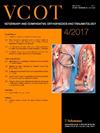穿针定位对骨折间隙模型中丙烯酸骨外固定物生物力学性能的影响。
IF 1
2区 农林科学
Q3 VETERINARY SCIENCES
Veterinary and Comparative Orthopaedics and Traumatology
Pub Date : 2023-11-01
Epub Date: 2023-06-19
DOI:10.1055/s-0043-1768990
引用次数: 0
摘要
目标: 本研究的目的是评估外骨骼固定器(ESF)丙烯酸柱中穿刺针定位的生物力学效果。研究设计: 建立了24个I型丙烯酸ESF,模拟裂缝间隙模型。转染针居中放置(n = 12) 或在柱直径的¼处偏心(n = 12) 在丙烯酸柱中。每组六个结构进行轴向压缩和四点弯曲试验。记录刚度、屈服载荷和破坏模式。结果: 刚度不受定心的影响(p = 0.373),但在四点弯曲中高于轴向压缩(p p = 0.535)和失效载荷(p = 0.715),也不影响弯曲时的屈服载荷(p = 0.135)。偏心销定位将弯曲时的失效载荷降低了28%(p 结论: 丙烯酸柱内穿刺针的偏心位置改变了I型ESF结构的生物力学特性。虽然丙烯酸提供了几个优点,但在形成柱时,如果销位于中心位置,则框架强度将得到优化。本文章由计算机程序翻译,如有差异,请以英文原文为准。
Effects of Transfixation Pin Positioning on the Biomechanical Properties of Acrylic External Skeletal Fixators in a Fracture Gap Model.
Abstract Objective The aim of this study was to evaluate the biomechanical effects of transfixation pin positioning in acrylic columns of external skeletal fixators (ESF). Study Design Twenty-four type I acrylic ESF were built simulating a fracture gap-model. Transfixation pins were placed centric ( n = 12) or eccentric at ¼ of the column diameter ( n = 12) in the acrylic columns. Six constructs from each group were subjected to axial compression and four-point bending tests. Stiffness, yield load and mode of failure were recorded. Results Stiffness was not influenced by centring ( p = 0.373), but it was higher in four-point bending than in axial compression ( p < 0.001). Pin positioning had no influence on the yield ( p = 0.535) and failure loads ( p = 0.715) in axial compression, nor on the yield load in bending ( p = 0.135). Eccentric pin positioning decreased failure loads by 28% in bending ( p < 0.001). Conclusion Eccentric position of transfixation pins within the acrylic columns alters the biomechanical properties of type I ESF constructs. While acrylic offers several advantages, when forming the columns, frame strength will be optimized if pins are centrally located.
求助全文
通过发布文献求助,成功后即可免费获取论文全文。
去求助
来源期刊
CiteScore
2.00
自引率
15.40%
发文量
49
审稿时长
18-36 weeks
期刊介绍:
Veterinary and Comparative Orthopaedics and Traumatology (VCOT) is the most important single source for clinically relevant information in orthopaedics and neurosurgery available anywhere in the world today. It is unique in that it is truly comparative and there is an unrivalled mix of review articles and basic science amid the information that is immediately clinically relevant in veterinary surgery today.

 求助内容:
求助内容: 应助结果提醒方式:
应助结果提醒方式:


